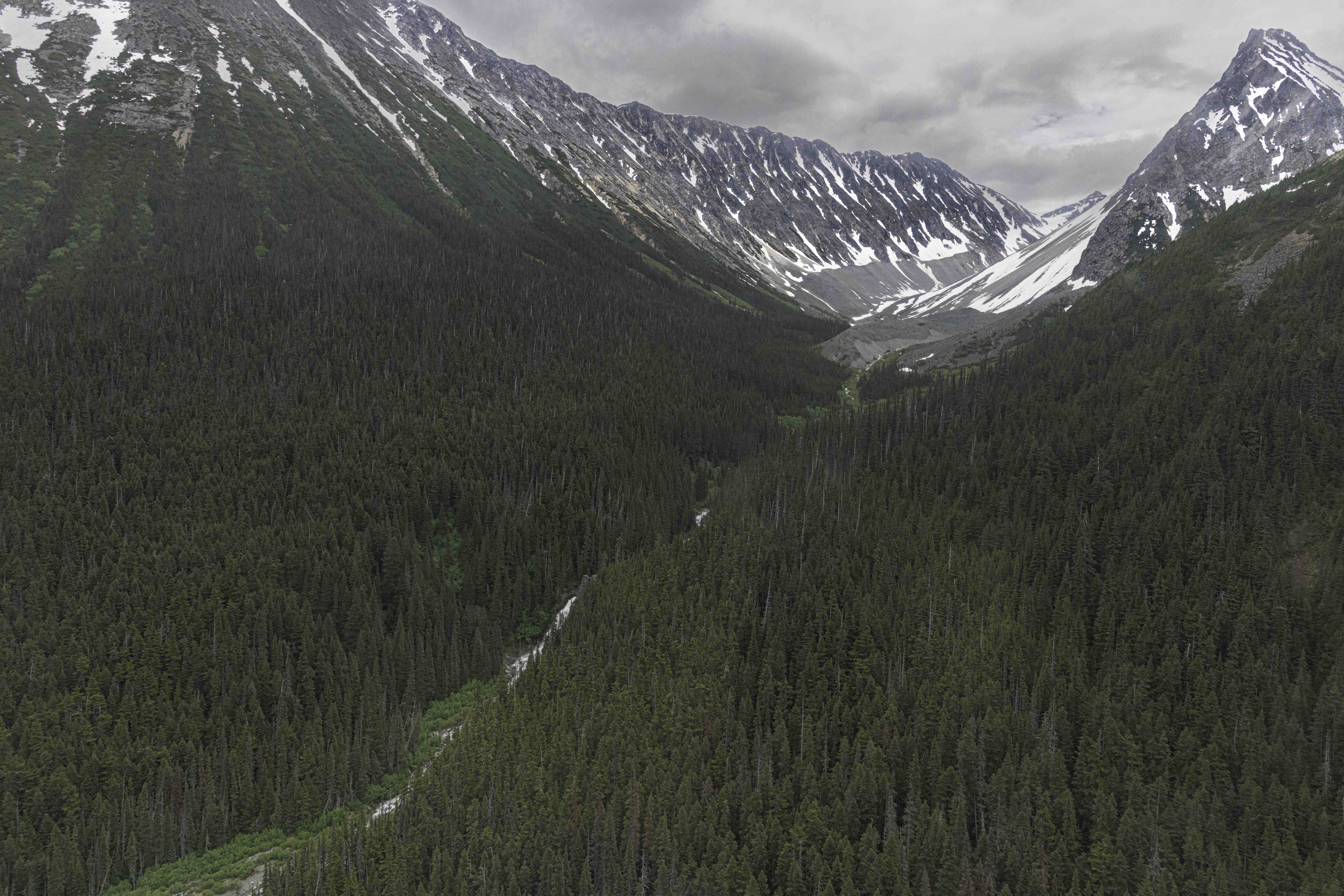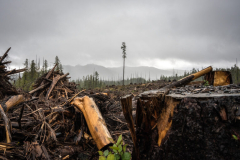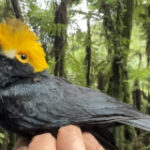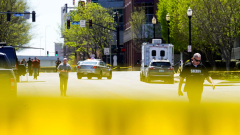- Members of Wet’suwet’en Nation in British Columbia want to conserve a pristine old-growth watershed, Caas Tl’aat Twah, in its traditional territory. The nation has obtained a logging deferral for Caas Tl’aat Twah and is planning how to protect it permanently.
- Scientists have shown that industrial logging can increase fire intensity in old-growth forests by drying out the land. Conserving remaining intact forests such as Caas Tl’aat Twah can prevent fires from getting even worse, they say.
- Logging companies have cut 80% of British Columbia’s forests. In 2020, the province reported that one-quarter of remaining forests were at high risk for logging and pledged to pause cutting while making land use decisions.
- But four years on, less than half has been deferred — and the province could ultimately authorize logging it.
WET’SUWET’EN, Canada — The pilot flew over squares of clear-cuts and tree plantations, then rolled the helicopter around Hudson Bay Mountain in north-central British Columbia. We were following directions from David de Wit, the acting director of the Office of Wet’suwet’en, who was navigating from a map of traditional trails in their territory.
On the ground, the trails are marked by culturally modified trees, circles carved into bark, proof of the Wet’suwet’en Nation’s history in this area. As we approached Caas Tl’aat Kwah (aka Serb Creek), a 1,600-hectare (3,900-acre) watershed that has not yet been logged or mined, the forest stitched together in a blanket of deep green, cleaved only by yellow-green wetlands threaded with glacial blue streams.
“We want to conserve it for future generations,” says Charlotte Euverman, the Wet’suwet’en woman leading a fight to save this area, which includes a traditional gathering and feasting site. “We have to leave them something.”
Like most First Nations here, the Wet’suwet’en never signed treaties with Canada or the province. Nevertheless, the latter took the land and leased forested areas to logging companies. Today just 20% of British Columbia’s old-growth forests remain. In 2020, after decades of activist pressure, the province released its Old Growth Strategic Review, a report that identified about a quarter of the remaining old growth as high risk for logging and recommended a pause while land use decisions were made. Yet four years on, logging has been deferred in less than half of the high-risk area.
First Nations and an array of species have paid dearly for the wide-scale logging, and now some forestry experts say its effects are being felt farther afield too.
Scientists are finding that industrial logging can contribute to the intensity and frequency of old-growth forest fires because it dries out the land. In summer 2023, more than 150,000 square kilometers (58,000 square miles) burned across Canada, an all-time record, carrying smoke across the continent and air pollution all the way to Europe and China.

Despite promises from the province’s Ministry of Forests, environmental activists say that classic “talk and log” delay tactics continue. Independent analysis by the Wilderness Committee, Sierra Club BC and Stand.earth found that 50,000-100,000 hectares (123,000-247,000 acres) of the at-risk forests have been logged or approved for logging in British Columbia since the province’s 2020 report.
“With so little old growth left, it is crucial [for the province] to step up to the plate for watersheds like Serb Creek and offer nations every support needed for long-term solutions,” says Jens Wieting, senior forest and climate campaigner with Sierra Club BC.
Before boarding the helicopter, de Wit led us in a ceremony, inviting us to rub charcoal on our cheeks. It’s a sign to their ancestors that we’re coming with respect, he explains, acknowledging that they reside on the land and that alpine places are sacred. Because the area is not yet accessible by road, nation members Caroline Muir and Sandra Harris were seeing it for the first time.
After 30 minutes of flying, the pilot waggled the helicopter down, setting it upon a boggy meadow. As we stepped out, Muir took a moment, eyes closed, hand on her heart. Harris stooped to examine the plants: low cedar (Diphasiastrum complanatum), Labrador tea (Ledum groenlandicum Oeder), frilly white bogbean (Menyanthes trifoliata) flowers.
Harris’ great-grandfather and Muir’s great-uncle, Jack Joseph, had a cabin here. It’s gone now, but we followed de Wit through the trees to a newer cabin. He opened his backpack and pulled out a framed photo of Joseph and nailed it to the wall in a place of pride.
Harris explained the significance of this moment for her. “We have a lot of stress in our lives with racism, working with colonial systems that are so unkind to our ways.” The land is healing, she says.
“Today, we can feel our ancestors. We remember our stories when we are able to put our feet on the land,” Harris says. “My spirit needs that. … There’s lots of good medicine there for us.”

Where there’s logging, there’s fire
Canadian governments’ commitments to reconciliation with First Nations and to biodiversity conservation might lead the Ministry of Forests to spare some of the remaining old growth. But the rise in extreme fires does not appear to factor into its calculus, says Torrance Coste, associate director for the Wilderness Committee. The link between logging and fires is “absolutely not” acknowledged by the province, he says.
Yet Coste says that industry lobby groups use the threat of wildfire to argue for more logging, saying, “We need to log these areas so they don’t burn.” That argument is driven by the conventional wisdom that increased fire severity is due not just to climate change but also fire suppression that created “fuel loading” — dense growth.
The Ministry of Forests would not make someone available for an interview. But a spokesperson wrote in an email that their approach to reducing wildfire severity is thinning (some logging) and prescribed burns.
Dominick DellaSala, chief scientist for Wild Heritage, says thinning forests only reduces fire severity in narrow circumstances. “It’s critical to leave large, fire-resistant trees in place,” he says, and not to remove too much of the forest canopy, which dries out plants and soil and allows winds to blow fires longer distances. Even if done right, benefits last only about a decade, he says, and only thwart fire when the weather isn’t too hot or dry.
Susan Prichard, a fire ecologist at the University of Washington, says thinning can be a helpful step before prescribed burns in certain ecosystems, such as interior Douglas fir and ponderosa pine forests that Indigenous peoples used to burn regularly. Outlawing the practice has led to overgrowth. Caas Tl’aat Kwah, on the other hand, contains interior cedar hemlock and Engelmann spruce subalpine fir ecosystems, with trees up to 350 years old. Prichard says thinning or prescribed burns in these types of forests would not reduce fire severity.
DellaSala and other scientists say the focus on fuel loading and thinning fails to recognize the way in which industrial logging increases fire severity: It kills complex communities of life that stabilize the water cycle, leading to much drier landscapes.
One paper that DellaSala co-authored looked at the severity of 1,500 fires in Western U.S. states over 30 years and found that protected forests, with higher levels of biomass [plants] and fuel loading, actually had lower fire severity than intensively managed areas of commercial logging. Another from 2018 found that “intensive plantation forestry characterized by young forests and spatially homogenized fuels, rather than pre-fire biomass, were significant drivers of wildfire severity.” Another from 2022 found that clear-cutting was a key factor leading to “frequent, high-severity fire.”
Other studies suggest that old growth reduces fire severity by retaining moisture and helping to generate rain. In an intact forest, dense, layered canopies of multiple species slow rain when it falls, and roots provide pathways for water to move underground. From there, it filters into creeks, wetlands and rivers over weeks and months. As trees photosynthesize, they release water vapor into the air, forming clouds.
They also release particles of microbes and fungi that help vapor coalesce into rain. Their rough surface slows wind, keeping moisture in the area. Old trees transpire more water, even through the dry season, because their roots tap groundwater from deep below. This phenomenon, called hydraulic lift, also distributes water to seedlings and weaker trees through the soil and mycorrhizal networks, keeping the whole forest moist, says University of British Columbia forest ecologist Suzanne Simard, author of Finding the Mother Tree.
Damp soil, plant litter and woody debris are filled with living beings — fungi, microbes, insects and other animals — that hold onto water for a long time and “really help with fire resistance,” Simard says.
For example, wild forests can hold more than 10 times the species of mycorrhizal fungi than young plantations. Trees feed the fungi via their own photosynthesis. After clearcutting, the few species that survive are not ones seen in old growth that are “big and fat and that really take up water and move it around the ecosystem,” Simard says.

Although British Columbia requires logging companies to replant after cutting, typically they install just a few marketable species. Deciduous trees such as maples, aspen and birch are less flammable; their stands create fire breaks in natural landscapes. But they are also less marketable, so standard operating practice is to kill their sprouts with herbicide, Simard says. Herbicides can also kill living matter in the soil, making it far less able to absorb water, contributing to drought and landslides.
These differences are obvious even to laypeople, Coste says.
“The forest floor is spongy and, if you dug in your hands, would have moisture, whereas the cut blocks are crispy and dry,” he says. And the lack of shade and evaporative cooling means that “walking from a standing forest into a clear-cut, the temperature can go up 15°.”
Harris has observed this too. “The soil health is a concern. Walking on our territory, it’s crunchy.” And because water isn’t filtering underground as much,







